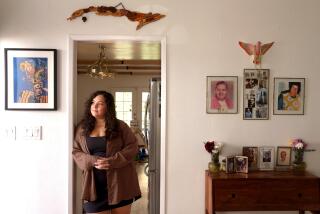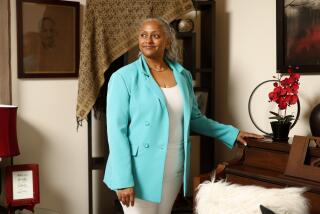Models Get Tough
Thirteen years ago, Carolyn Fears left her rural Illinois home at 19 to join Ford Models in New York. The 6-foot redhead landed jobs in Manhattan and Europe, appeared on billboards, magazine covers and in numerous ads, eventually earning as much as $100,000 annually. As glamorous as modeling seemed, Fears learned early on how tough the business could be.
âWhen I was first starting, I went to the agency to get my paycheck, and they were taking $1,500 out of it. I said, âWhat is this?â One of the owners was standing behind me and said, âThatâs to put you in the agencyâs book. I donât see you on the cover of Vogue. If you donât like it, get out.â I went into the bathroom and cried,â Fears recalled. âItâs intimidating and you just want to please everybody. Youâre not thinking about the commissions and fees.â
Last week, Fears, 32, joined five other California models in filing a class-action lawsuit in New York federal court against eight top modeling agencies, alleging that the firms violate the law by fixing fees and charging far more in commissions than is legal. Fears hopes the lawsuit will give models with New York agencies more protection and a larger share of their earnings. The case, filed by a partner of antitrust heavy hitter David Boies of Boies, Schiller & Flexner, alleges that New York modeling agencies have been fixing prices on fees for nearly 30 years.
According to the lawsuit, models are given form contracts, which the agencies claim are standard and not subject to negotiation. Few complain because like Fears and co-plaintiffs Amanda Masters, Lorelei Shellist, Barbara Cheeseborough, Carla Gross (also known as Sebastian Cardon) and Justin Klentner, they are concerned that they may be blacklisted--a key reason it has taken so long for the allegedly illegal practices to come to light, according to Brian Rishwain, a partner in the Los Angeles firm Johnson and Rishwain, which has joined the case.
âYou start modeling so young that you are just so happy to be doing it,â said Fears, who lives in Sunset Beach and opened a surf shop with her earnings. âYou naturally get wiser as you get older, and by that point, you might be getting out of the industry and not care.â The case involves California residents partly because Rishwain, a former model, was familiar with the industry and knew local models. Andrew Hayes, the Boies partner who filed the case, added that recently discovered documents and reports from individuals helped bring what the suit is alleging to be a decades-old conspiracy to light.
The models, who are in their 30s and 40s, accuse the agencies of violating federal antitrust laws and New York state laws regulating employment agencies. According to the lawsuit, the Wilhelmina Model Agency, Ford Models, Elite Model Management and five other New York agencies conspired in the 1970s to set the fees they charge to models, and to fix terms of their contracts. In addition, the lawsuit challenges the long-standing practice whereby agencies collect a 20% commission on the modelâs earnings and charge an additional 20% commission to the modelâs employers. The eight agencies represent more than half of the New York market, measured by total volume of bookings, according to the complaint.
âI look at it as a 40% commission,â said Fears, who said that her first Ford agency written contract didnât mention that the client would be paying Ford an additional 20% to hire her. New York state law allows any employment agency to collect only a 10% commission. However, the modelsâ lawyers said that modeling agencies have for years presented themselves as managers, not employment agencies, in an attempt to avoid the limit on commissions.
âThe bottom line is, if you are a manager of a model, it would be a conflict of interest to be taking money from the person who is employing that model, without the modelâs consent or awareness of it,â said Rishwain.
Joey Grill, vice president of Click Model Management in New York, one of the defendants, called the suit âridiculous.â The other New York agencies named in the case, Next Management Co., Boss Models, Zoli Model Management (which was recently purchased by Click) and Company Management, would not comment or return repeated telephone calls. Modeling agencies not named in the suit arenât voicing concern, according to Heinz Holba, president and founder of L.A. Models, which is not a target of the suit. âI donât think this thing has any merit, and neither does anyone else,â said Holba, who noted that California agencies are governed by different laws. However, according to Rishwain, the commission rates are the same in California and New York.
Most of the models involved in the lawsuit are edging toward the ends of their careers and have established other sources of income, which helps shield them from potential backlash. Jobs have become scarce in the slow advertising climate following Sept. 11, making many models averse to more risk. Shellist, of San Diego, was reluctant to discuss the case because she still works as a model, in addition to using her fashion experiences to teach teen girls about self-esteem. âWho wants to bite the hand that feeds them?â she said. âThe majority of us make a normal, average living,â said Fears, who estimated the average salary of a successful model at $40,000. âThere were years that I was borrowing money from my parents to get by.â
Some models said they began to question their agenciesâ practices after taking acting jobs and discovering that under Screen Actors Guild rules those commissions were limited to 10%. Klentner, who lives in Los Angeles and is one of the plaintiffs, compared models to other professionals with short careers, such as athletes, who typically have better job benefits.
âMy only real concern has always been that whenever I did commercials or acting jobs, I had a pension or health insurance,â Klentner said. âIâm 39, and I have friends who started to model before I did and truly have no job skills. On top of that, they have no pensions or health benefits. Thereâs an actorsâ old age home, but thereâs nothing like that for models,â said Klentner, who now designs and builds custom homes in Los Angeles.
âIâm doing great now,â said the Michigan native who once modeled for GQ, Vogue, Calvin Klein and Versace, âbut I have so many friends who are in a really hard place now.â Unlike actors, models have never been able to build a strong union.
Though Klentner made a nice living and had good experiences as a model, heâs not convinced that others will be as fortunate. He doesnât like what he sees: âThese agencies are getting rich, rich, rich off of 15-year-old girls and 18-year-old guys.â
Models rarely challenge the practices of their agencies because they are often young, naive and afraid, Fears said, noting that the far-flung nature of the jobs has created a disjointed atmosphere conducive to potential abuses. âModels travel a lot, they donât work [as models] for very long and they donât work together in groups,â she said. âWe donât really have co-workers, and no one gets together and talks about it. If they do, they are totally intimidated and afraid to try and change the system.â
According to the lawsuit, modeling agencies allegedly used meetings of a trade group, International Model Management Assn., to fix rates and terms of modelsâ contracts. The IMMA includes several of the agencies named in the suit.
Modeling agencies have been coming under increasing scrutiny in recent years. Five years ago in Texas, the consumer affairs division of the state attorney generalâs office investigated the fees that modeling agencies were charging aspiring models to attend model search seminars.
Hayes said that the New York practices have gone unchallenged because agencies can exploit the inexperience of their charges.
âMost of the people who come into the business are young and told that it [the commission] is standard,â said Hayes, whose firm won price-fixing cases against Sothebyâs and Christieâs auction houses.
âThe models ask around and find out that it is standard. Uniform pricing, regardless of market conditions, and lack of competition on price, is often a sign that something else is going on,â Hayes said. âItâs not proof in and of itself, but it makes you wonder why there isnât any competition.â
The burden of commissions falls hardest on the legions of lower-paid, less famous models who fill catalogs, department store ads and other lower-profile assignments. âContracts can be negotiated for top supermodels,â Rishwain said. âEveryone else has no bargaining power in negotiating.â
For the models who have joined the suit, most said the issue isnât money but the principle. They want to change the practices for the many others who are still working. âThere is no safety net,â Fears said. âYou go at your own risk and try to get some money out of it. It doesnât last forever.â






